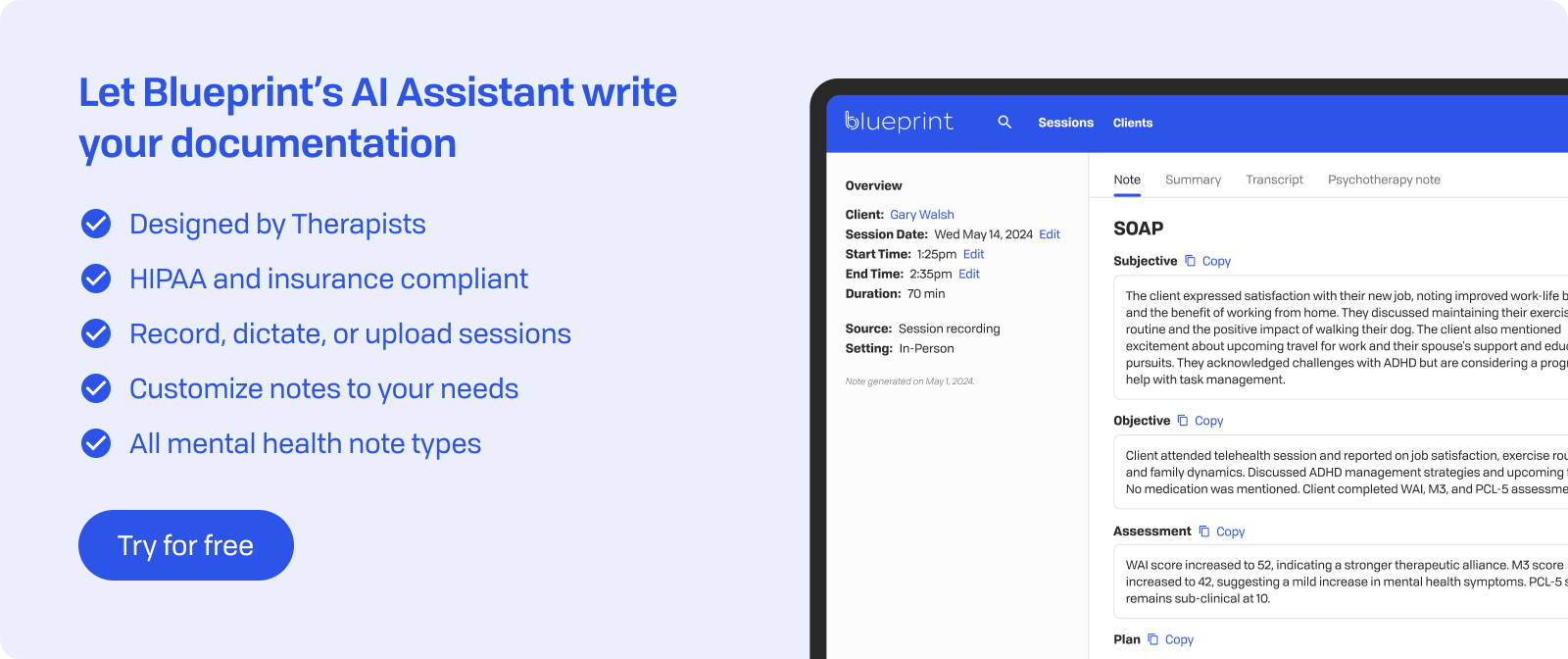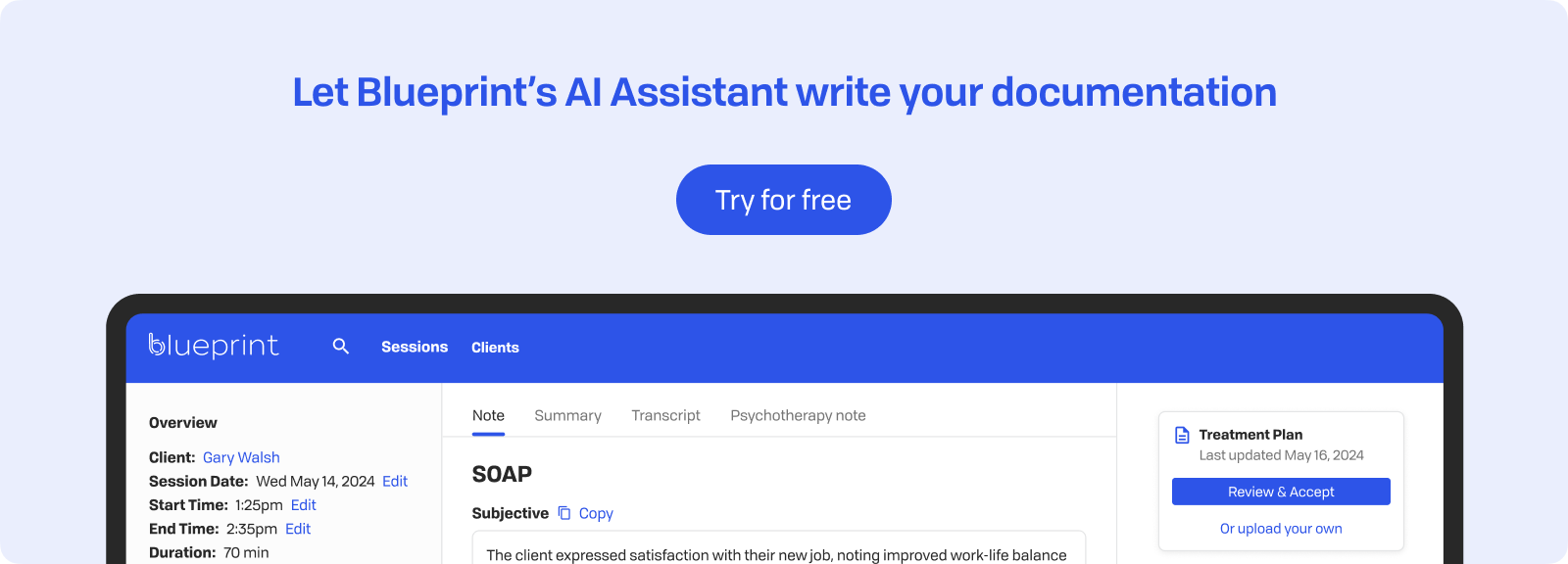In Brief
Imagine a new therapist sitting across from their supervisor, grappling with a challenging case that's caused sleepless nights. They're looking for guidance, validation, and assurance that they're on the right track. This scenario happens often in our field, highlighting how essential professional development is in shaping careers and protecting client welfare.
We don't make the journey from novice to experienced clinician alone. Behind every confident therapist lies a history of supervisory relationships that have challenged, supported, and refined their practice. Yet, supervision can feel mysteriously different depending on who you ask and where you trained.
Whether you're getting ready to receive supervision, stepping into a supervisory role, or just curious about best practices, it's important to understand the nuances of this professional relationship. Supervision covers much more than just case consultation—it's a multifaceted process that combines skill development, ethical guidance, and personal growth.
The Role of Supervision in Clinical Development
Therapy supervision offers a structured, hierarchical process that promotes professional growth while ensuring ethical practice and client safety. Unlike casual peer discussions or informal mentoring, supervision involves a formal evaluative component where an experienced clinician oversees a developing therapist's work. This relationship creates a protected space for learning through direct observation, case review, and systematic feedback that directly affects client care.
New professionals often confuse supervision with consultation and mentoring, but understanding these differences is important. Consultation typically involves peer-to-peer exchanges where professionals seek specific expertise without an evaluative component. Mentoring focuses on career development and professional identity formation through a more informal, supportive relationship. Supervision, however, combines elements of both while maintaining clear boundaries around evaluation, gatekeeping responsibilities, and legal accountability for client welfare.
From graduate training through licensure and beyond, supervision acts as the backbone of clinical development. During training years, it provides the scaffolding for translating theoretical knowledge into practical skills. Post-graduation supervision hours fulfill licensing requirements while offering continued support during the vulnerable transition to independent practice. Even experienced clinicians benefit from ongoing supervision when learning new modalities, working with unfamiliar populations, or navigating complex ethical dilemmas.
The supervisory relationship creates a unique learning environment where clinicians can examine their reactions, biases, and blind spots. Through regular meetings, therapists develop the reflective capacity essential for effective practice. This process of guided self-examination helps identify countertransference, recognize personal limitations, and develop strategies for managing the emotional demands of clinical work.
Beyond individual growth, supervision serves broader professional functions by maintaining standards across the field. Supervisors act as gatekeepers, ensuring that only competent, ethical practitioners advance through training programs and licensure processes. This quality control mechanism protects vulnerable clients while upholding the integrity of the profession as a whole.

Functions of Effective Therapy Supervision
Effective supervision serves three interconnected purposes that help develop competent, ethical clinicians. Knowing how these roles complement each other allows both supervisors and supervisees to make the most of their time together.
Educational Function
The educational part forms the foundation of supervision, focusing on skill development and knowledge integration. Supervisors assist therapists by:
- Improving clinical techniques: Refining intervention strategies, timing, and therapeutic presence through observation and direct feedback
- Connecting theory with practice: Linking academic concepts to real-world application in sessions
- Enhancing case conceptualization skills: Learning to organize client information into coherent treatment frameworks
- Broadening therapeutic repertoire: Introducing new modalities and approaches suited to specific client needs
Supportive Function
The supportive aspect addresses the emotional demands of clinical work, acknowledging that therapist well-being directly affects client care. This role involves:
- Exploring emotional reactions: Creating space to discuss countertransference and personal triggers
- Building resilience: Developing strategies to manage vicarious trauma and compassion fatigue
- Preventing burnout: Encouraging sustainable practice through self-care, boundary-setting, and workload management
- Reducing isolation: Providing connection and validation in what can be solitary work
Evaluative Function
The evaluative part ensures professional standards while promoting growth through constructive feedback. This includes:
- Monitoring ethical practice: Reviewing decisions against professional codes and legal requirements
- Assessing competency development: Tracking progress toward clinical milestones and learning objectives
- Providing accountability: Maintaining documentation standards and treatment planning rigor
- Gatekeeping responsibilities: Ensuring readiness for independent practice or advanced training
These roles operate simultaneously, with effective supervisors seamlessly integrating education, support, and evaluation throughout each supervision session.

https://clinician.blueprint.ai/signup/you?utm_source=SEO&utm_medium=BlogandShare
Models and Modalities of Supervision
Selecting the right supervision format can greatly influence professional growth and learning outcomes. Each approach offers specific benefits that cater to various developmental needs and practice settings.
One-on-One Supervision stands as the standard for personalized attention and thorough exploration of clinical work. This traditional approach allows for in-depth discussions of countertransference, detailed case reviews, and feedback tailored to individual learning needs.
Group Supervision takes advantage of peer learning while maintaining expert guidance. Participants gain from a variety of perspectives, shared experiences, and learning through others' cases. This format is particularly helpful for developing a professional identity and building support networks among colleagues.
Peer-Led Supervision encourages experienced clinicians to guide each other without a formal hierarchy. Although it lacks evaluative elements, this model promotes collaborative problem-solving and reduces isolation among seasoned practitioners.
Live Observation offers immediate, contextual feedback through direct session viewing. Conducted through one-way mirrors or video technology, this intensive approach accelerates skill development with real-time coaching.
The rise of tele-supervision has changed accessibility and flexibility in professional development. Remote formats provide:
- Geographic freedom: Access to specialized supervisors regardless of location
- Enhanced scheduling: Eliminating travel time allows for more frequent sessions
- Cost efficiency: Lower overhead costs make supervision more affordable
- Real-time observation: Screen-sharing and remote viewing capabilities maintain the quality of supervision
Choosing the right modalities involves considering developmental stage, learning goals, and ethical requirements. Newer therapists often gain from intensive one-on-one or live supervision, while experienced clinicians might opt for peer consultation. Legal and ethical guidelines, especially for pre-licensed professionals, may require specific formats and frequencies to ensure adequate oversight and client protection.

Key Components and Structure of Supervision Sessions
Productive supervision sessions require careful planning while allowing enough flexibility to address new needs as they arise. The most effective supervisors create a collaborative environment that encourages supervisees to take charge of their learning journey.
Setting a Collaborative Agenda forms the basis of each session. Instead of enforcing a strict structure, experienced supervisors encourage supervisees to identify their most pressing concerns, challenging cases, and areas where they feel unsure. This shared agenda-setting process typically includes:
- Case review priorities: Determining which clients need immediate attention versus ongoing monitoring
- Skill development goals: Focusing on specific interventions or theoretical concepts for further exploration
- Professional growth areas: Discussing confidence, ethical dilemmas, or career development questions
- Administrative needs: Making sure documentation, treatment planning, and compliance issues are up to date
Supervision Tools and Techniques enhance learning through various approaches:
- Case presentations: Structured narratives that help organize clinical thinking and recognize patterns
- Role-playing exercises: Practicing difficult conversations or trying new interventions in a supportive environment
- Session recordings: Reviewing actual therapy moments for detailed feedback on verbal and non-verbal communication
- Process notes: Analyzing the therapist's internal reactions and decision-making during sessions
The skill lies in balancing structure with adaptability. While maintaining consistent elements like check-ins and case reviews offers stability, effective supervisors stay aware of immediate needs. A supervisee arriving distressed about a client crisis needs the opportunity to process before moving into planned activities. Similarly, moments of new understanding merit time for exploration, even if it means adjusting the agenda.
Addressing Ethical and Cultural Considerations
Ethical and cultural awareness is the backbone of responsible supervision. The supervisory relationship involves power differences that need careful handling, as supervisors have evaluative authority while supervisees are in a vulnerable position when sharing their struggles and uncertainties.
Exploring countertransference becomes particularly complex in supervision, operating on multiple levels:
- Client-therapist dynamics: How the supervisee reacts to their clients
- Supervisee-supervisor dynamics: The parallel processes emerging in supervision itself
- Cultural countertransference: Reactions stemming from cultural differences or similarities
Clarifying confidentiality boundaries requires explicit discussion and ongoing clarification. Supervisees need to understand what information gets documented, who has access to supervision records, and when supervisors must break confidentiality for ethical or legal reasons.
Cultural humility goes beyond mere cultural competence, requiring supervisors to:
- Model ongoing self-reflection: Openly examining their own cultural biases and limitations
- Create safety for cultural exploration: Encouraging discussions about race, ethnicity, gender, sexuality, and other identity factors
- Maintain a curious stance: Prioritizing curiosity about the supervisee's and client's cultural contexts over assumptions
- Foster critical consciousness: Helping supervisees recognize how systemic factors influence clinical work
Supervisors show ethical decision-making through transparency about their reasoning processes. When facing dilemmas, effective supervisors think aloud, illustrating how they weigh competing ethical principles, consult relevant codes, and make decisions. This modeling teaches supervisees to approach ethical challenges systematically rather than reactively.
The intersection of ethics and culture often presents the most challenging supervisory moments. Supervisors must recognize when their own cultural perspective might limit their view and actively seek consultation to ensure they're supporting culturally responsive practice.

Strengthening the Supervision Relationship
Trust forms the foundation of meaningful supervision, yet it develops gradually through consistent, intentional actions. Creating psychological safety means both parties can share vulnerabilities, admit mistakes, and explore difficult topics without fear of judgment or professional consequences.
Building this foundation requires:
- Transparent communication: Clearly outlining expectations, supervision structure, and evaluation criteria from the beginning
- Consistent reliability: Being prepared, maintaining regular meeting times, and following through on commitments
- Non-judgmental stance: Viewing mistakes as opportunities for learning rather than failures
- Appropriate self-disclosure: Supervisors sharing relevant struggles to normalize the learning process
Active listening involves more than just hearing words; it means understanding emotional undertones and unspoken concerns. Effective supervisors ask open-ended questions that prompt deeper exploration: "What was happening for you in that moment?" or "Help me understand what made that interaction challenging." Supervisees play their part through honest self-reflection and a willingness to examine their own reactions.
Empathy works both ways—supervisors understand the vulnerability of being evaluated while learning, and supervisees recognize the responsibility supervisors carry for client welfare. This mutual understanding fosters authentic dialogue about clinical uncertainties.
Reflexive practice thrives when curiosity replaces defensiveness. Encouraging supervisees to wonder aloud about their clinical choices, emotional reactions, and theoretical assumptions shifts supervision from performance evaluation to collaborative exploration. Questions like "What might I be missing?" or "How else could I understand this?" promote the reflective stance essential for ongoing professional development.
Supervisor Development and Ongoing Growth
Taking on the role of a supervisor doesn't signal the end of professional development—it marks the start of a new learning phase. Just as therapists need guidance, supervisors gain from supervision of supervision, a practice that refines skills and helps avoid the development of blind spots.
Engaging in supervision of supervision includes:
- Peer consultation groups: Meeting regularly with other supervisors to discuss challenging cases and supervisory dilemmas.
- Formal training programs: Completing specialized coursework in supervision theory, ethics, and multicultural considerations.
- Direct observation: Having experienced supervisors watch and provide feedback on supervision sessions.
- Credentialing processes: Working toward formal supervisor credentials that require documented training hours and ongoing education.
The mental health field changes quickly, making it important for supervisors to stay up-to-date. This involves regularly reviewing new research on supervision effectiveness, understanding new therapeutic approaches, and adapting to evolving ethical guidelines. Many states now require specific continuing education hours focused on supervision skills, acknowledging that effective supervision demands distinct abilities beyond clinical expertise.
Staying current involves:
- Reading supervision-specific journals: Staying informed about best practices and emerging models.
- Attending supervision-focused conferences: Learning from experts and networking with peers.
- Engaging with diverse perspectives: Seeking training on cultural responsiveness and curiosity in supervision.
- Regular self-assessment: Using supervision competency scales to identify growth areas.
Humility remains key in supervisor development. Experienced supervisors model lifelong learning by acknowledging their limitations, seeking advice on challenging cases, and being open to feedback from supervisees. This attitude shows that professional growth is ongoing, regardless of years of experience or credentials earned.

Key Takeaways
Therapy supervision plays a vital role in professional development, shaping competent clinicians who can confidently and ethically navigate the complexities of mental health care. The path from a novice to a skilled practitioner relies on quality supervision that addresses not just clinical skills, but also self-awareness and professional identity.
Effective supervision combines three main functions:
- Teaching: Enhancing clinical skills and theoretical understanding through active learning
- Support: Offering emotional support and preventing burnout through empathetic engagement
- Evaluation: Ensuring ethical standards and competency through constructive feedback
The collaborative nature of the supervisory relationship fosters a unique learning environment where both parties contribute to professional growth. This partnership thrives on mutual respect, clear communication, and a shared commitment to client welfare.
Choosing the right supervision models requires careful consideration of:
- Developmental needs: Matching the format to the supervisee's experience level
- Learning objectives: Aligning methods with specific skill-building goals
- Practical constraints: Considering geographic, financial, and scheduling factors
- Ethical requirements: Meeting licensing and regulatory standards
Both supervisors and supervisees must develop reflective habits that promote ongoing growth. This includes regular self-examination, openness to feedback, and a willingness to explore challenging areas like countertransference and cultural biases.
Ethical rigor in supervision involves more than just following rules; it includes modeling ethical reasoning, creating psychological safety for difficult discussions, and maintaining appropriate boundaries while fostering authentic connections.

How Blueprint can help streamline your workflow
Blueprint is a HIPAA-compliant AI Assistant built with therapists, for the way therapists work. Trusted by over 50,000 clinicians, Blueprint automates progress notes, drafts smart treatment plans, and surfaces actionable insights before, during, and after every client session. That means saving about 5-10 hours each week — so you have more time to focus on what matters most to you.
Try your first five sessions of Blueprint for free. No credit card required, with a 60-day money-back guarantee.
























